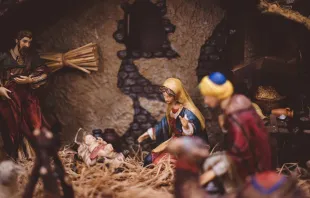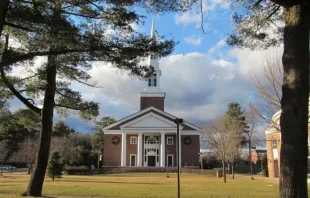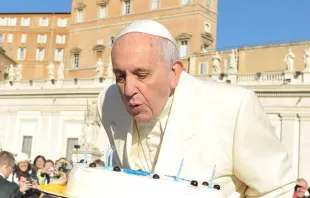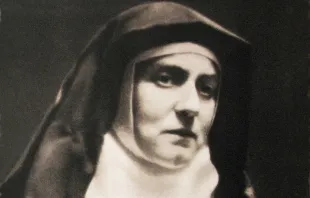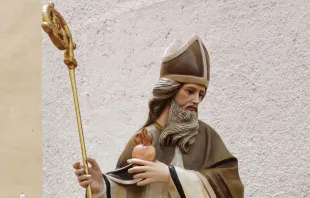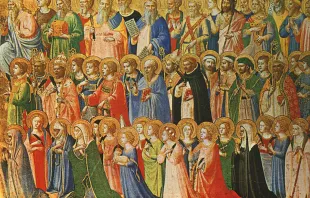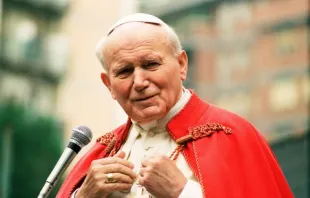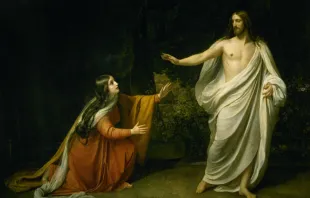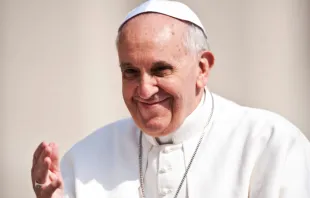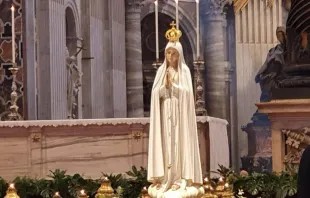Articles by Tina McCormick, PhD
The Pain beneath the Cross
Apr 3, 2017 / 00:00 amAs Catholics, we are not thin-skinned when we encounter and personally experience pain. We are taught about the redemptive qualities of pain and suffering and are taught to embrace it as did Christ. Many saints endured physical suffering to the extreme and identified with Christ in his passion. Various saints chose ascetic practices as part of their vocations. Saint Teresa of Kolkata, not content with ministering to the poor and dying, practiced physical “discipline,” which included self-flagellation and the cilice, to experience the cross more fully and demanded her sisters do the same. To her, pain was no less than a “kiss of Jesus” on the cross. Yet traditional explanations of the fall of man and our sinfulness may strike us as rather cold, the assurance of redemption through the cross, the sharing of Christ’s cross, as wholly unsatisfactory consolation in the face of life’s struggles and worst horrors. Recently a fire claimed the lives of a mother and four of her five children in the small town of Warwick, Massachusetts. During an unusually cold night in early March, a wood stove in the kitchen caused the infernal blaze. Only the father and one child escaping before the roof collapsed. How, indeed, are we to make sense of such senseless suffering? Most of the time, suffering seems to occur without a valid reason and we fail to see a connection between pain and deserved penance. We might celebrate as a miracle the healing of an eighty-year old following a hundred rosaries but are bewildered when God does nothing to save a four-year old from torture and rape. When faced with suffering of such magnitude, redemptive justifications leave us perplexed. It seems reductionist and anti-climactic should God’s mercy, love, and power require any contribution on our part when life’s horrors unfold before our eyes. More satisfying answers must, therefore, be sought outside of the theology of sin and redemption. The key to the mystery of suffering, its causes, its respite, and its role in our salvation, must lie in the fact that God is not only good and omnipotent, but also omnipresent through Christ. Rather than absent from, complaisant in, or even responsible for suffering, God is with us through it. And Christ’s passion on the cross is less a call to share his pain, but, rather, a statement about his closeness to the pain we already endure. Many of us can become impatient with the apparent glorification of pain, the exaltation of sharing Christ’s passion and focus on heaven, rather than the here and now. Our earthly tasks are far from over and we seek consolation and solutions to real time challenges. We have jobs, homes, and families and children who require our presence of mind in concrete existential matters and their education. As mere mortals, outside of the orderly world of the consecrated, we encounter a world that is arbitrary and unpredictable, cruel, and often frightening. Not only do we endure suffering, but each day brings new and unforeseen challenges that we cannot just face passively in prayer but must overcome in action. When faced with the greatest challenges, the idea of redemption and the promise of heaven provide neither guidance nor respite. When we look at the cross, we seek not theological justification for pain and its exaltation, but consolation. Simply put, we long for a love that helps us endure the pain, not one that demands it. Not all suffering is the same and neither are its causes. Yet all suffering is an essential part of life and the pre-condition of our freedom. Much suffering results from natural catastrophes, famines, diseases, and accidents. The mercilessness and harshness of the natural world as just as essential to the functioning of nature as are its beauty, grandeur, and abundance. Much, maybe most, suffering is caused by human actions. Conversely, it is human actions that allow for God’s love to become manifest. Throughout our lives, we are likely to encounter various types of suffering. First, there is the suffering caused by sin, the willful separation from God, from his graces and the true source of love. Secondly, there is suffering we voluntarily choose in the form of sacrifice in order to direct our attention from the self towards spiritual matters, towards God and the needs of others. Thirdly, as Christians we may experience ridicule, abuse, exclusion, torture, even martyrdom. Fourth, we experience the unavoidable suffering through the various challenges that are essential to life in a natural world of imperfection and potential – disappointments, failures, anxiety, sadness, loneliness, uncertainty, and physical pain. Such a world is the pre-condition of true freedom and only freedom allows us to love God freely. Finally, there are the great tragedies of life for which we know no words. The loss of a child, chronic and excruciating pain, disfigurement, sudden and senseless death. Such tragedies lead to despair and cynicism, to a breaking point. We might always believe, but life’s struggles may become so overwhelming that even the promise of heaven does not prevent us from “opting out” from God’s plan in anger like Dostoyevsky’s Ivan Karamazov. Mere mortals that we are, we suffer with no end in sight, only believing and hoping for life eternal. And believing is not knowing. Faith is, above all, trust and not certainty. In Lumen Fidei, Pope Francis acknowledges that “Christians know that suffering cannot be eliminated.” He further points to its possible meaning as “an act of love and entrustment into the hands of God who does not abandon us” and as serving “as a moment of growth and faith” (Encyclical Letter, Lumen Fidei, # 56). But how are we to accomplish this “act of love and entrustment” in the midst of trial and life’s greatest challenges? We must take heart in the familiarity we have gained with God through Christ. Rather than make himself be seen in spectacular and marvelous ways, God incarnate is now in our midst. Urgent requests for visible signs have become obsolete. According to St. John of the Cross in The Ascent to Mount Carmel, “now that faith in Christ is given and the evangelical law is manifested in this era of grace, there is no need to inquire in this way, nor that He speak or respond as before. For by giving us, as He has done, His Son, His unique Word – there is no other – He has spoken and revealed all things at one time in one Word. There is no need to speak further” (Subida del monte Carmelo, II, 22, Obras completas, ed. L. Ruano de la Iglesia (Madrid, 1989), #3, pp. 200-201). What are we to make of this paradox of simultaneous closeness and distance? Prayer must no longer be request for miracles, but, rather, an assent to and rejoicing in the consolation already present. In other words, Christ is the answer to all prayers. Faith often starts with the sense of security that a small child might feel when holding the father’s hand. Inevitably comes a time, when the hand lets go and we feel alone in darkness. It is at such times that reflections on sinfulness and redemption offer little solace. Instead, the Christocentric theological vision of Blessed John Duns Scotus can lead us back to the cross as a symbol of love and a guiding light. Scotus held that God’s uniting with himself the whole of creation was not contingent on man’s fall and that, in fact, the Incarnation was the fulfillment of creation, God’s “original idea,” and the ultimate sign of God’s immense love. Pope Benedict XVI, in his biography of the 13th century Franciscan friar, applauds Scotus’ vision in which “Christ is the center of history and of the cosmos; it is he who gives meaning, dignity, and value to our lives!” (Holy Men and Women, p. 89). Christ’s passion, which is integral to the Incarnation and the Resurrection, must in this sense also be understood culmination and completion of God’s work. A Christocentric vision affirms that God does not want us to suffer. Indeed, Christ suffered so that we may suffer less. Christ’s pain is, indeed, God’s sharing in the pain of the world, like a mother’s longing to absorb the pain of her child in her arms. Christ’s pain on the cross is a symbol of pure love and a concrete manifestation of God’s empathy. (See also: http://www.catholicnewsagency.com/cw/post.php?id=763) Once we accept his closeness, we are comforted and can become models of his love. According to Pope Francis, God’s response to suffering is “that of an accompanying goodness which touches every story of suffering and opens up a ray of light” (Lumen Fidei, # 57). It is in this encounter that we not only feel loved but feel emboldened to face and overcome life’s obstacles. No longer feeling chained to the cross, we may come to recognize that our pain is not a “kiss from Jesus.” On the contrary, we may recognize his love in acts of human kindness and goodness in the most unlikely places. With Christ as our companion, we are, ultimately, set free, loved and thus able to love. This is the true victory over despair that comes through the cross. In the French director Anne Fontaine’s most recent masterpiece, The Innocents, Benedictine nuns in a Polish convent find themselves at a loss with how to deal with the consequences of their brutal rape by Soviet soldiers at the end of World War Two. Only the courage to act creatively and according to the dictates of love rather than those of the convent allow for God’s graces to shine through. As one of the Sisters states, “we cannot know what God wants. The only truth is His love.” As to the mother and her children who perished in the fire, we must believe that God sent angels to lift them up to his embrace.
A New Year’s Revolution
Jan 5, 2017 / 00:00 amResolutions: there are many this time of year, as in any year. Be it plans to exercise, to be healthy, or otherwise successful, our ambitions know no bounds. But are our ambitions misplaced? Are they in sync with what they ought to be following the momentous event we just celebrated? Thomas Aquinas had his own battles with gluttony, but regardless, his brilliant mind carried him toward saintliness. Likewise, Catherine of Siena’s saintliness was informed not by surviving on a leaf of lettuce a day (purportedly her diet), but by far greater deeds. Indeed, our plans following Christmas should have less to do with specific resolutions than with the revolution that is Christmas. The story of the infant laid in the manger of a cave conjures up images of a sweet and comforting harmony, of a peaceful family scene, humble worship, and songs of angels. Yet this story stands at the beginning of all things and is also its end. It signifies God’s final answer to our pleas of ever greater closeness and calls us to battle with the world. It is the story of a revolution and provides the measure for our lives as Christians. As such, it should rattle, not comfort us. According to G.K. Chesterton in Everlasting Man, “it might be suggested, a somewhat violent image, that nothing had happened in that fold or crack in the great grey hills except that the whole universe had been turned inside out. I mean that all the eyes of wonder and worship which had been turned outwards to the largest thing were now turned inward to the smallest.” To Chesterton, there was something “defiant” about the event, “something that makes the abrupt bells at midnight sound like the great guns of a battle that has just been won.” Christ’s birth in a cave signified an “undermining the world; of shaking the towers and palaces from below.” In fact, Bethlehem was the place where the extremes of “omnipotence and impotence” met and created the ultimate paradox: “The hands that had made the sun and the stars were too small to reach the huge heads of the cattle.” And God had become man “like an outcast or even an outlaw.” Indeed, Bethlehem showed a world turned upside down. From now on, Chesterton wrote, “there could be no slaves….Individuals became important, in a sense in which no instrument can be important. A man could not be a means to an end, at any rate to any other man’s end.” In other words, God’s entering time in the form of an infant in a cave gave recognition to man’s true dignity. Christ’s entry into the world as an infant in a cave brought to a point all of scripture and opened the way to ever greater union with the Father. The rest would be up to us. A grand drama, indeed. But where do we fit in? As Catholics, we have a whole arsenal of shortcuts to feel in sync with God’s plan for this world and our desires to enter the next. We offer up our pain as penance, we pray the rosary and pray for our friends, and we blame the devil for the evil in this world and our own failures. We are quick to pray, but slow to act. We are quick to lament and condemn, but hesitate to take responsibility. We fail to recognize fatalism, complacency, self-referential piety, and judgmentalism as the dangerous personal demons they are. We are often afraid to leave our comfort zone. In short, we tend to be the pious worshippers who linger at the manger, blinded by the star above and too timid to move on. Instead, we should take our cues from the other actors in the play. The shepherds and Wise Men were men of action, men on the move who wasted no time. The shepherds “went with haste” to the manger to “see this thing that has happened, which the Lord has made known to us.” (Lk 2:15f.) They heeded the angels’ message and “were not afraid.” The message of the manger is that God is love. But the nature of this love puts us on a revolutionary path. Pope Benedict XVI reminds us that “love can also be hated when it challenges us to transcend ourselves. It is not a romantic 'good feeling.' Redemption is not 'wellness,' it is not about basking in self-indulgence; on the contrary it is a liberation from imprisonment in self-absorption. This liberation comes at a price; the anguish of the Cross. The prophecy of light and that of the Cross belong together.” (The Infancy Narratives (New York, 2012), p. 86) The image we have of the three Magi reflects the magnificent dignity that comes from this love that is also sacrifice. Dressed like kings and bearing precious gifts, the three travelers invite us to share in such dignity as we make our personal journey of faith and ever greater closeness to God. But to follow their path, we must have courage to not only recognize our personal limitations but to also transcend them through a life of active love that both accepts and gives. To Pope Benedict XVI, “the wise men from the East are the new beginning. They represent the journeying of humanity toward Christ. They initiate a procession that continues throughout history. Not only do they represent the people who have found the way to Christ: they represent the inner aspiration of the human spirit, the dynamism of religions and human reason toward him.” (The Infancy Narratives, p. 97) St. Paul encountered the laziness and complacency that stands in the way of such a grace filled journey. He reprimanded Thessalonians: “We hear that some among you are idle. They are not busy; they are busybodies.” (2 Thessalonians 3:11) Let us not be idle or comfortable or too pious then, but let us follow the Magi in their quest, always on the move and ready to share the glorious truth they discovered.
Teresa of Kolkata: A radical humanitarian
Sep 15, 2016 / 00:00 amMother Teresa, the most recent Catholic saint, is, indeed, a saint for all. Catholic, or not, people around the world know Mother Teresa of Kolkata as a woman who gave her life to tending to the abandoned and desperate. The Missionaries of Charity, an order founded in 1950 by the humble yet strong-willed Albanian nun to give “wholehearted free service to the poorest of the poor” is seen throughout the world as practicing the gift of self in service of the poor. Today, there are more than 4,500 Missionaries throughout the world. They run orphanages and hospices as well as centers to care for refugees, the blind, disabled, aged, alcoholics, the poor and homeless, and victims of floods, epidemics and famine in more than 100 countries around the world. Saints of the Catholic Church are generally considered role models for a Christian life. There are more than 10,000 saints recognized by the Church – at least one with whom every variety of human personality can relate and imitate. There are, of course, some whose lives and saintliness resonate with only Catholics. Some of those with wider appeal, such as Saints George, Christopher, and Valentine appear to be more folklore than real. But there are certain Catholic saints whose real life examples reach far beyond the limits of Christian identity. Their lives are a testament to what it means to be fully human in a relational way.Mother Teresa of Calcutta was just such a saint. She epitomized the Christian faith in a way that touches human hearts beyond the limits of religious denomination. She was a radical humanitarian whose life and works should challenge any observer to ponder life’s purpose and the purpose of their actions. Many Catholics have focused on Mother Teresa’s “darkness within,” her testimony to feeling an internal emptiness and to, at times, feeling abandoned by God. Her agony over not feeling God’s presence within has been likened to Christ’s sense of abandonment on the cross, a reliving of Christ’s suffering. Many a Christian can relate to moments of such divine silence and the accompanying sense of loneliness, and it a consolation for many that a contemporary saint felt the same. But this narrow reading of this unique woman does a disservice both to Catholics and to all of humanity. In fact, Teresa’s great works were, in fact, evidence of the God she longed for inside. With her practical labors of love and care for the desperate and abandoned, she bore witness to the loving God she hoped to find. As God worked through her, Mother Teresa became the reflection of a love that unites all of humanity, a deep commitment to the humanity we all share. According to Rodney Stark, it was the humanitarian works of the early Christian communities that instigated most conversions. When others shuttered their doors or fled the cities during diseases and natural calamities, Christians stayed and tended to the sick and injured. Early Christianity was focused on building communities centered around care for one another and it was this impulse that left a lasting imprint on observers. It was a faith of action, humanitarian service, and community rather than an introverted, self-centered faith. God was seen to speak through a Christian rather than to a Christian. A Christian was known, above all, through his deeds. Like the early Christians, Teresa’s dedication to the poor deepened the faith of others and drew many non-believers to the faith. It is her actions, not her internal darkness or loneliness, that make this Catholic nun be a saint for all humanity. There has been much cynicism and petty criticism of the Missionaries of Charity even during Mother Teresa’s canonization process. Just as this steadfast woman will be remembered as a light to the world, she will also remain a thorn on the side of those whose who feel threatened by the radicalism of her sacrifice and dedication. Many critics of the saint seem to reject examples of true voluntary sacrifice for the sake of others and the charity that ultimately leads to communion among people. Have people become too self-referential, jaded, and shallow to appreciate true goodness? Indeed, Princess Di’s death in August of 1997 was mourned with hysteria, Mother Teresa’s death only five days later received much less media attention. But that’s the story of the saints. Princess Di might very well continue to have admirers and dedicated fans who cannot resist the appeal of her fairy tale life of glamor and personal disappointments. Yet her celebrity status will fade with the passing of her generation. Mother Teresa’s radical humanitarianism, on the other hand, will help define the history of charity and will continue to serve as a universal example of kindness. The communities she built were true examples of charity and love and the only possible witness to the God she could not find within. This column first appeared in the NewBostonPost Sept. 10, 2016, and is reprinted at CNA with permission.
The need to compromise
Jan 21, 2016 / 00:00 amThe topic of abortion has divided this country for more than half a century. And while the imminent March for Life in D.C. this coming Friday bears witness to a civic activism that is peaceful, both sides of the debate on abortion have tended to add to national divisiveness. A consensus based on compromise seems unlikely in the near future. On both sides of the debate, the most vocal activists are entrenched in their positions. We are called upon either to prove our “pro-life” bona fides by opposing abortion under all circumstances (including rape and life of the mother) or else demonstrate that we support a woman’s unfettered right to abortion on demand (paid for by the taxpayers) through the end of the third trimester. Indeed, many a defender on either side of the spectrum will separate friend from foe according to the litmus test of abortion absolutism. It seems that both sides have managed to pitch woman against child, mother against baby. Meanwhile, the United States continues to have the highest abortion rate among Western countries (although, thankfully, it is starting to drop). In 2007, 22.9 of 1,000 women had abortions in the US; in Western Europe, that number was only 12 of 1,000. Why? In Western European nations, supporters and opponents of abortion managed to reach national compromises soon after abortion was legalized. All European countries allow abortions through the first trimester, but most ensure a process that allows a woman to consider her options. In several countries, such as Germany, the Netherlands, and Belgium, women are obligated to wait several days before having an abortion and must provide particular reasons for wanting to terminate the pregnancy. In Europe, abortions through the second trimester are only permitted when the mother’s mental and physical health is at serious risk or grave fetal defects have been discovered. Such restrictions are not regarded as a “war on women,” as they would be in this country. They have not led to a decline in women’s health, nor have they held women back professionally. To be sure, America does not provide the same level of assistance for women, in terms of maternal healthcare, child care, and family-friendly workplaces. But looking at Europe’s handling of the abortion issue illustrates the way that compromise may serve women and protect the lives of the unborn. Indeed, the majority of Americans would prefer restrictions on abortion while generally keeping it legal. But unfortunately, the political parties in this country remain rigidly divided on the abortion question. Consequently, the political debate on abortion is largely driven by the most extreme positions. In effect, politicians are both restricted by the stakes laid out by the opposing camps, and stoke the fire by playing to their constituencies. To them, it often makes sense to score politically through simplistic talking points rather than engage in debates that allow for the complexity of the life issue. Abortion is closely tied up with other big issues of our times, such as the position of women in our society, the economy and the cost of living, welfare, health care, and education. It is far too important to be reduced to a vehicle of scoring political points based on whether a candidate is “for” life or “for” choice. Because of the way that the issue of abortion is simplified and misrepresented, regular women and mothers have become either pawns or helpless spectators in a cultural battle between activists and politicians. The high emotions of this cultural battle result in the failure to confront the diverse problems that make women opt out of motherhood in the first place. In 2008, 58 percent of women who had abortions were in their 20s, 86 percent were unmarried, and 57 percent were economically disadvantaged. Generally, one in five pregnancies end in abortion. While women who choose abortions come from a large cross-section of society, they have one thing in common: a sense of inability to care for a child within their personal circumstances. Most are driven to abortion by fear and desperation. What triggers that fear and desperation should be first on the agenda of any abortion debate. Those who favor legalized abortion need to help create a cultural environment in which motherhood is celebrated, not questioned on principle, and in which women who find themselves with unwanted pregnancies are encouraged not to throw their children away but to give them up for adoption. At the same time, those who wish to protect the unborn must commit societal resources to maternal health and support for women who opt to keep their babies. The problem extends to other areas that deserve attention when discussing abortion. The US infant mortality rate of 6.1 per 1,000 live births in 2009 is a national embarrassment. (Mississippi’s infant mortality rate was 9.6 per live births.) By comparison, Germany’s infant mortality rate was 3.4. Similarly, the number of pregnancy related deaths in America tops the list of all Western countries. In 2013, with 18.5 mothers dying for every 100,000 births, the US ranked 60th among 180 countries, with China ranking 57th. With 800 yearly deaths, the US number was triple that of the UK. These numbers are an outrage and, when ignored, clearly make a farce of the heated rhetoric that claims to defend either women or the unborn. So long as the women’s rights activists continue to make abortion the sine qua non of women’s health and autonomy, and so long as the pro-life movement refuses to compromise on the hard cases, we miss opportunities to save lives while also improving women’s autonomy, maternal health, and child welfare. Both sides of the cultural and political debate would do well to ponder the message set forth by Serrin Foster of Feminists for Life, namely, that “abortion is a reflection that we have not met the needs of women.” The lives of women and children are inextricably entwined. And American voters and politicians would do well to remember the importance of compromise in order to reach the type of modus vivendi required by any democratic society. In the end, more babies will be saved and more women will be helped, if an agreement on keeping abortion both safe and extremely rare, on protecting maternal and children’s health, and on providing necessary resources to women to be mothers can be reached. The theme of this year’s March for Life, Pro-Life and Pro-Woman Go Hand-in-Hand, is a step in the right direction. Originally posted on NewBostonPost. Used with permission from the author.
Why the Christmas spirit has power beyond Christianity
Dec 27, 2015 / 00:00 amYes, indeed, it is the season of giving. But, most of all, it is the season of giving in to the stress and anxiety of buying just the right thing — or at least something — that will please the receiver, from the slightly estranged relative we’ll meet under the Christmas tree to the tyrannical child whose wishes haunt us through the crowded stores. We enjoy an overload of cheap Chinese merchandise, and sales of all kinds lure us into endless lines, parking lot rivalries, traffic gridlock, and late-night internet splurging. Then there’s the endless wrapping with stacks of paper, all to end in a messy pile within minutes. It is the things, material and tangible, we seem to care most about. As parents, how could we possibly sacrifice first impressions of Santa’s generosity for the sake of “less is more”? But as hard as this question is to confront just a couple of days before Christmas, we should ask ourselves, for Christmas’ sake, “is more really more?” Shocking as it may be to those of us who find ourselves in a whirlwind of buying, propelled by a fear that we might not be giving enough, or not the right “thing,” the real Christmas is really more about receiving than it is about giving. And this message carries meaning for Christians and non-Christians alike. Christians celebrate the birth of Christ. Lest we forget, Christ was born in a manger, the humblest of settings, to tell us a few crucial things about love and mercy, and then to die on the cross to save the world. His birth had little to do with the material overload that the celebration of Christmas has become. Indeed, the three Magi brought gifts. But before joining in the shopping race, be aware of the symbolism of those gifts. Gold was a gift befit of kings, frankincense was the source of light for prayer, and myrrh was to embalm the dead. The Magi knew that no gift could ever suffice to honor a God who lowered himself to be with us in human form. Their visit, while bearing gifts, was a gesture of welcoming and receiving rather than giving. And this is where any person, Christian or not, can recognize the significance of the true Christmas gift. The Christmas story has power beyond the Christian faith. The story of Christ’s birth in Bethlehem is the story of a gift, of a God becoming man to give himself to all. For Christians, Christmas is a call to accept this gift. Christmas calls Christians to be generous by opening their hearts to the love contained in the message of the incarnation. Yet, this gift has strings attached and shows just how humbling a true gift can be. God’s gift through Christ humbles the faithful and points to their human shortcomings. Such “humbling” can occur in many ways. A guest who rejects the host’s generosity might not do so out of true modesty, but rather, because he lacks generosity of heart. It is a generous act to accept the kindness of others. By accepting, we acknowledge a need; we acknowledge our longing for acceptance and love, and we indicate to those giving that they have something to give. Without such generosity of an open heart to receive love, we are inept in love. Truly accepting and appreciating others, no matter the strings attached, is much harder than checking off a shopping list. True generosity means patience, appreciation, sometimes humor, vulnerability, and always a willingness to receive. Rejecting someone’s kindness is the opposite of generosity as it bars us from appreciation and renders us incapable of giving. No cheap material trick can free us from the obligations of true generosity. Let’s not allow that cheap trinket to come between our prickly relative and us! Rather, let’s pay attention to the value of the person, and discover what gives meaning to life. Let’s acknowledge that the “spirit of Christmas” should be just as much about receiving as it is about giving. Let’s be kind and cheerful, rather than stressed and obsessed with material things. Posterd with permission from New Boston Post.
The curse of Santa
Dec 21, 2015 / 00:00 amChristmas, the most beloved and widely celebrated holiday, is upon us. Yet while many long to experience Christmas joy, there are signs of a veritable Christmas war in schools, at cash registers, and on the phone with strangers. Public institutions and certain principled organizations are adamant about keeping faith out of public places, and many endure daily moments of awkwardness at cash registers or with strangers on the phone over the choice of holiday versus Christmas greetings. Rather than point the finger, as many do at political correctness or liberal politics, I would like to suggest that the cause of the dying of the Christian Christmas has all along been … Santa. Yes, that jolly, burly fellow with the white beard, who once a year plops through the chimney with gifts, is the ultimate secularizer. Everyone knows that the story of the virgin birth has nothing to do with a red-coated, sleigh-flying chap and his reindeer. And Christmas warriors would do well to recognize that it is Santa, not politically correct strangers or government bureaucrats, who has been chipping away at Christmas joy for years. Critique of Santa’s cultural takeover is hardly new, but goes back to heated debates in the 1920s when the Santa cult had just taken off. In America, the first Santa appeared at the Edgar Department Store, originally called the “Boston Store,” in Brockton, Mass., in 1890. People traveled from as far as Rhode Island to have their children sit on Santa’s lap. During the 1920s, “retail Santas” multiplied and commentators were quick to complain about the materialism tied up with Santa’s storefront omnipresence. Santa, who began as a simple impostor standing in for the venerable and dignified Greek Bishop of Myra, the real Saint Nicholas, soon turned into a department store caricature for giving and, inevitably, spending. Fitting the good humor personification of Christmas, the American Christmas has become synonymous not only with shopping marathons, but with a holiday cheer replete with jazzy, funky, upbeat Christmas tunes. As a Catholic from Germany, I love the American party version of Christmas, of sipping eggnog and “dancing around a tree” to cheerful, happy holiday songs in green and red velvet holiday attire. But is that all that’s left in our culture of Christmas? If Santa is the only reminder of a deeper religious meaning of Christmas, Christmas warriors don’t have much of a case. Some have attempted to rescue both Santa and Christmas from secular misinterpretations while playing along with their cultural manifestations. The argument goes that Santa stands for generosity and family closeness and celebrates the wonder of childhood by making children the focus of attention. This, Santa defenders would argue, maintains the link to the “real” Christmas. But, by propping up the myth, Christmas warriors have lost more than they have gained, as Santa is more guilty of taking the mystery out of the Christmas than anyone. The so-called “Christmas truce” of 1914 reminds us of a deeper, more universal meaning of Christmas. On Christmas day in 1914, five months after the outbreak of World War I, about 100,000 German, French, and British soldiers laid down arms and emerged from their trenches to exchange gifts across enemy lines and bury their dead. Most accounts agree that this legendary truce began with the singing of carols such as “Adeste Fideles” and “Silent Night.” The spontaneous fraternization that took place on that day bore witness to a recognition of a shared humanity and a longing to remain hopeful through the celebration of a common joy, the celebration of hope and light emerging with the birth of Christ. It is unlikely that tunes of “Jingle Bells” or “Rockin’ around the Christmas Tree” would have inspired similar fraternization in the midst of trench warfare. Surely, defenders of Christmas must keep in mind the true meaning of Christmas before battling to defend Christmas just for the sake of saving Christmas. According to scholarly consensus, the Church chose to celebrate the nativity on Dec. 25 to rival and top popular pagan festivities such as Roman Saturnalia and the Winter Solstice, celebrating the end of darkness and the return of light, on the same date. Yet, the Christmas story is much older than even that. The pattern of the virgin birth and a savior being born goes back to ancient myths of Egypt, Babylon, and Mesopotamia. In fact, the story of hope and salvation is a universal theme that has meaning beyond the Christian story of Mary, Joseph and Jesus. The longing for hope and salvation has run deep within humanity since the beginning of history. It is a longing that transcends the concerns of our time and that finds answers in deep personal reflection and the powerful simplicity of the real Christmas story, not the jingle and cheer of the modern Christmas cocktail party or shopping desperation. If everybody could pause, turn off the cheery tunes, dim the lights, and settle down, we might all embrace the Christmas season as an opportunity to reflect on themes that run deeper than Santa’s beard. What the Christmas season means as a symbol to all is that we long for meaning and that we long for hope and ultimate salvation, in our messy, difficult world. We all long for answers and a sense of purpose and belonging. Coming together with our families for Christmas and exchanging gifts are important elements of Christmas celebration. Yet beyond the specifics of our own Christmas traditions and the omnipresent Santa, there looms the larger question of meaning in life. Reflecting more deeply, we might come to realize that family and friends are important not only at Christmas time, but always. Love, manifested in family connections and deep friendships, gives meaning beyond the Christmas tree, just like the legends and stories of a savior being born reflect any human’s longing for greater meaning and hope. To a Christian, the gifts that Christ bears for humanity don’t come through the chimney, but are discernible all around, each moment of every day of the year. Christ might not be everyone’s answer, but he points the way to what hope personified might look like – a baby in a humble manger born to challenge the world. Once we discover the true revolution that Christ brought to this world with his message of hope, the jingle of American Christmas might more readily be exchanged for the triumphant sounds of real bells that proclaim the birth of a savior. Posted with permission from New Boston Post.
Gordon College prevailed, but will the country?
Dec 14, 2015 / 00:00 amGordon College, the small Christian liberal arts college just 30 minutes north of Boston, became the focus of much negative media attention just over a year ago. Its president, D. Michael Lindsay, had signed an open letter to President Obama, supporting a religious exemption to his Executive Order prohibiting federal contractors from discriminating on the basis of sexual orientation. President Lindsay has emphasized the need to grant faith-based institutions the freedom to “hire for mission” and for religious colleges to “set the conditions for community life.” But soon after, the New England Association of Schools and Colleges took the college’s accreditation under review to determine whether Gordon’s prohibition of same-sex relations among students and staff might bar it from receiving federal funds. On both sides of the issue, followers of the story tended to see it as just another skirmish in the culture wars. The case is now closed, with Gordon’s accreditation renewed in May of 2015, after all. Although the college is still reeling from the media’s onslaught, local hostility, and resulting divisions within its student body, it has weathered the storm and stands resolved in its principles. But Gordon’s muted challenge to federal authority is just the beginning of what this nation will face as many rise to the defense of one of its founding principles, namely, religious freedom. The fury over Gordon’s destiny raises the question of what kind of country we want to live in and what the extent of tolerance might be. The answer must be both more sweeping and more complex than simply “a country rooted in Judeo-Christian family values.” Whether you are a gay marriage advocate or an evangelical home-schooler, there is more to this issue than a clash of values. Much will be lost if those on either side assume that their personal values must be applied universally and by force. True pluralism must accommodate diversity of religious belief. Americans must embrace difference, rather than force homogeneity, and rally around basic principles of individual liberty and civic responsibility. Such constructive engagement has its roots in our Declaration of Independence, which is bold in that it appeals to a brotherhood of all. In doing so, it inspires in us notions of individual potential while transcending particularistic interests to serve the common good. As such, American pluralism both enriches our country and poses a healthy challenge to each one of us, namely, to not succumb to self-righteous complacency and to justify our own values through civic service. Gordon College is all about the common good. Its students are actively involved in local and national mentoring and aid programs and its commitment to helping the poor and needy is exemplary. Gordon students spend time in the poorest regions of the world, providing orphan care and instruction, assisting in construction projects, and volunteering in leper colonies. Their commitment and dedication to charity and service is unassailable. One might not embrace the Christian ideals that motivate Gordon students, but it’s impossible not to admire the humanitarian initiatives that they compel. Gordon College may have survived the challenge to its religious principles, but unfortunately, Catholic Charities of Boston did not. In the spring of 2006, the organization, which provides the needy with vital support and whose official mission it is to “build a just and compassionate society rooted in the dignity of all people,” fell victim to anti-religious bigotry. Catholic Charities was the biggest and most experienced adoption agency in Massachusetts, but its licensing contract came up for renewal. Between 1986 and 2006, it had placed 720 children in adoptive homes with more than half of them being foster children who had been abused or neglected. At that time, Catholic Charities handled 31 percent of “hard” cases (older children, sibling groups, special needs children and those who had suffered trauma), while the remaining 52 percent were handled by seven separate agencies. The licensing requirements for adoption agencies in Massachusetts include the signing of a pledge to obey state law. Yet the Massachusetts ban on “orientation discrimination” of 1989 and the legalization of same-sex marriage in 2003 put the pledge at odds with Church teaching. Furthermore, in order to proceed with its focus on “hard cases,” Catholic Charities needed to contract with the State Department of Social Services, which, similarly, would not tolerate the groups’ insistence on male-female-parenting couples. In March 2006, Catholic Charities of Boston stopped providing adoption services. To some, this was a victory for gay marriage. The real losers in all of this? The children. Critics of faith communities fail to recognize the integrity of faith as a coherent system of belief. Although it is understandable that some feel offended by particular tenets of Catholicism or of evangelical belief, it is also understandable that institutions such as Catholic Charities and Gordon College need to be able to act in accordance with their beliefs. Different aspects of diversity might seem offensive to some, but America can only thrive and, in fact, survive, if diversity of belief is allowed to flourish. As G.K. Chesterton, the English master of wit, rightly pointed out in the early 20th century, the American Constitution is founded on a creed. Yet, Chesterton was also quick to point out that there was a “danger of tyranny becoming the temptation of America,” namely, the danger of wanting to control a person’s beliefs. Are we, in fact, veering towards an American despotism of consciousness today? Groups with opposing views need not like each other and they can bring their own lunch to the table, but be civil and sit down together they must. For such is the nature and the hopeful adventure of the American public sphere. The American ideal is one of a harmony of differences through a workable civic culture. Yet, once the precarious balance of mutual respect is undermined, we risk an Orwellian dictatorship, where opinions are subject to public sanction. In Chesterton’s words, “the Americans are doing something heroic or doing something insane.” Let’s be heroic and grant institutions like Gordon College and Catholic Charities the right to exist on their own terms, and let’s not forget to exalt our unique national commitment to the defense of religious freedom.
Pope Francis — a comforting, uncomfortable pope
Sep 25, 2015 / 00:00 amPope Francis is the spiritual leader of 1.2 billion Catholics worldwide. There are bound to be some who don’t like him. But what is of greater interest is that so many non-Catholics love him. In fact, this week’s People magazine features Pope Francis on its front cover and describes him as a saint for all. A local witness to the Pope’s visit to Cuba called him “the most loved man in the world.” There is ample evidence of Pope Francis’ global appeal. No doubt, this church leader has what it takes to be a leader in today’s world. In the US, many of the pontiff’s comments have lent themselves to ideological manipulation. Proponents of socialist ideals, pro-life activists, gay rights supporters, environmentalists, all have felt affirmed by the Pope’s remarks. Politicians and interest groups are, no doubt, eagerly awaiting further affirmation during his US visit. But when political-ideological groups attempt to co-opt the pope’s words to serve their own interests, it not only cheapens the Pope’s intentions, it misses the point entirely. Popes do not fit into American categories of left and right — they transcend them. To be clear, at no point has Francis contradicted or questioned traditional Catholic doctrine, which mostly runs counter to the outlook of particular interest groups. If anything, he has only amplified it. His call for mercy to the marginalized, kindness to the condemned, and hope to the hopeless does not mean that the Church condones the entire spectrum of human behavior and lifestyle choices. The pope’s mission is spiritual, not political, and this is what makes his message so powerful. Pope Francis’ popularity is, above all, due to his style of engagement and the powerful humanistic elements of his faith. He moves people to tears when he emphasizes the need for compassion and reaches out to his audience with kindness. Above all, he has succeeded in transcending rigid ideological and political barriers. The Catholic Church suffers from fragmentation along cultural and political lines — perhaps never more explicitly than during the conclave that chose Cardinal Bergoglio as her spiritual head. Shortly before his election on March 13, senior cardinals called for greater unity in the Church and worried about the risk of schism between “ultra-traditionalists and ultra-progressive extremists.” Cardinal Bergoglio, still Archbishop of Buenos Aires, knew the cause and already had an answer. To him, “self-referentiality,” or an inward focus of the Church, had led to an alienation from the real world and to theological rigidity. He called priests, religious, and lay people to engage with the “existential margins” of society, guided by compassion and energized by the joy of a common faith. Many Catholic saints have “gone to the margins,” dedicating their lives to serving the poor and neediest. Mother Teresa of Calcutta is just one example. However, what sets Pope Francis apart is not his concern for the needy, the outcasts, and lonely, but his ability to communicate such dedication with joy from the pulpit, through social media, and on a global stage. He leads by example but also offers a message that inspires the world at a time when societies are torn apart by ideological divisions. Since his election as pope, conflicts within the Catholic Church have hardly been resolved. However, through Pope Francis’s leadership, all sides have been challenged to focus on the essence of Christianity and to live their faith with passion. He has succeeded in reshuffling entrenched positions within traditionalist and liberal/progressive camps of the Church and has, by focusing on the poor and “wounded” and on “fraternity,” brought attention to the early foundations of Christianity. In America, this message clearly separates Catholicism from national “culture wars.” His conciliatory and collegial approach to leadership has been manifested by his reliance on non-curial cardinals for advice and by holding the Synod on the Family, called to convene for the second time in October. Furthermore, he has reached out to other religions in a fraternal way. Pope Francis has consistently shown that he is a man of dialogue, a leader with an open heart and an open mind. American politics, too, would benefit from such re-direction. Our leaders have much to learn from the Catholic pontiff who transcends ideology and internal division through a more humane rhetoric and a willingness to listen. True leaders rise above pettiness and political theater and inspire through strength of character, a focus on our shared humanity, and common sense. “Service is never ideological,” the pontiff proclaimed during the Mass on Havana’s Plaza of the Revolution, “for we do not serve ideas, we serve people.” Pope Francis is immune to temptations of political maneuvering or manipulation. He cares nothing for power politics or votes. Instead, he has the liberty to speak the truth and to provide comfort, from a spiritual and humanistic point of view, that people are longing to hear. His call for all to work for the common good proves powerful in a culture that celebrates individualism and is out of touch with bigger questions of meaning and human connection. He has not only emerged as a global spiritual leader, but has articulated the characteristics of true leadership. When addressing Brazilian bishops in 2013, Pope Francis called upon them to “above all” instill hope. And he outlined the structure of leadership: “The Bishop has to be among his people in three ways: ahead of them, pointing the way; among them, keeping them together …; and behind them, ensuring that no one is left behind, but also, and primarily, so that the flock itself can find new paths.” Can American politicians learn from Pope Francis? They should. And if they do, we might end up with a leader who can guide our nation by inspiring us and challenging us to be the best Americans we can be in constructive engagement with one another and the rest of the world. This column originally posted on NewBostonPost and is posted with permission.
Happy Birthday and Thank You, Pope Francis!
Dec 17, 2014 / 20:17 pmHappy Birthday, Pope Francis! You are a true gift to this world and to our Church. It is through your insistence on love that you have redirected our faith to its original essence.
A Death of Desperation
Nov 5, 2014 / 19:56 pmBrittany Maynard is dead. She chose to end her life of 29 years with lethal medication on November 2. She thus precluded an inevitable ordeal of physical and mental decline due to an aggressive brain tumor.
Fearless Hildegard: A saint for extroverts and doers
Sep 17, 2014 / 19:47 pmHow do modern, outspoken, confident women fit into the daily life of the Catholic Church? To find an answer to such age-old questions and fresh inspiration for today’s gutsy women, we need look no further than 12th-century Germany and the life and works of Hildegard von Bingen.
The glorious cross of Edith Stein
Aug 9, 2014 / 19:42 pmWhen Edith Stein entered the order of Discalced Carmelite nuns in 1933, she assumed the name of Teresa Blessed by the Cross. What did she mean by the seeming paradox of being “blessed by the Cross”? It is the echo of St. Paul's words to the Galatians: “Far be it from me to glory except in the Cross of our Lord Jesus Christ (6:14) .”
A Saint for everybody
Aug 4, 2014 / 14:03 pmRecently, a dear friend of mine asked me for advice. Her father had just been diagnosed with terminal cancer and, being a convert, she wasn’t sure which saint she should turn to in such a seemingly hopeless situation. Raised as a Lutheran, she still had reservations about the possibility of saintly miracles in moments of crisis.
Oh, to be a saint!
May 20, 2014 / 13:58 pm“I’m not a saint!” is perhaps one of my most frequent utterances, along with more forceful expressions such as “No!”, “Do your homework!”, “Get ready for bed!”, “Get into the car!”, or, simply “Listen!” While the harsh tone of the latter statements might be shocking to outsiders, the tone of the former comes closer to a temptation to despair and surrender.
Mother Monica, Saint of all Nags
May 13, 2014 / 13:33 pmAs mothers, sainthood is often promised to us by people who don’t know the half of it. Do they know the whole truth of what goes on in the chaos of our homes? The image of Mary as serene, always receptive, giving, and gentle mother – even as we do know the pain she suffered and the leap of faith she took in her yes to the angel Gabriel -- can make us feel inadequate.
John Paul, a Saint for women
May 6, 2014 / 13:26 pmPope John Paul II’s legacy is momentous. To most of us growing up in the late twentieth century, Pope John Paul II was the quintessential pope. Omnipresent and highly charismatic, this pope was a venerable force in the world as the representative of our truly universal Church.
Easter every day!
Apr 25, 2014 / 13:20 pmMany Christians, myself included, become upset at the widespread reluctance to say “Merry Christmas.” However, our outrage over a lack of appreciation of Christ’s birth should be trumped by a sadness over a common indifference about Easter. Try saying “Happy Easter” at check out and you are likely to encounter perplexed and confused looks.
Christ, Fully Human
Apr 15, 2014 / 13:10 pmAs Lent nears its end and we anticipate the Lord’s Passion and the glory of Easter, our focus is, above all, on Christ, the Lord, whose death on the cross brought salvation to mankind and whose resurrection brought hope to all.
Unexpected joy
Mar 13, 2014 / 13:04 pmAs the world anxiously awaited the election of a new pope a year ago, I confess that I was bracing myself for battle. I was eager for battle with the world and for a leader who would give clear marching orders
Mary, Mother of Saints, Mother of All
Feb 2, 2014 / 12:26 pmMotherhood and abortion are two topics often viewed as separate. In fact, we tend to focus almost exclusively on the child when condemning the act. However, maternal love seen as an absolute value must not be absent when addressing the tragedy of killing the unborn.




